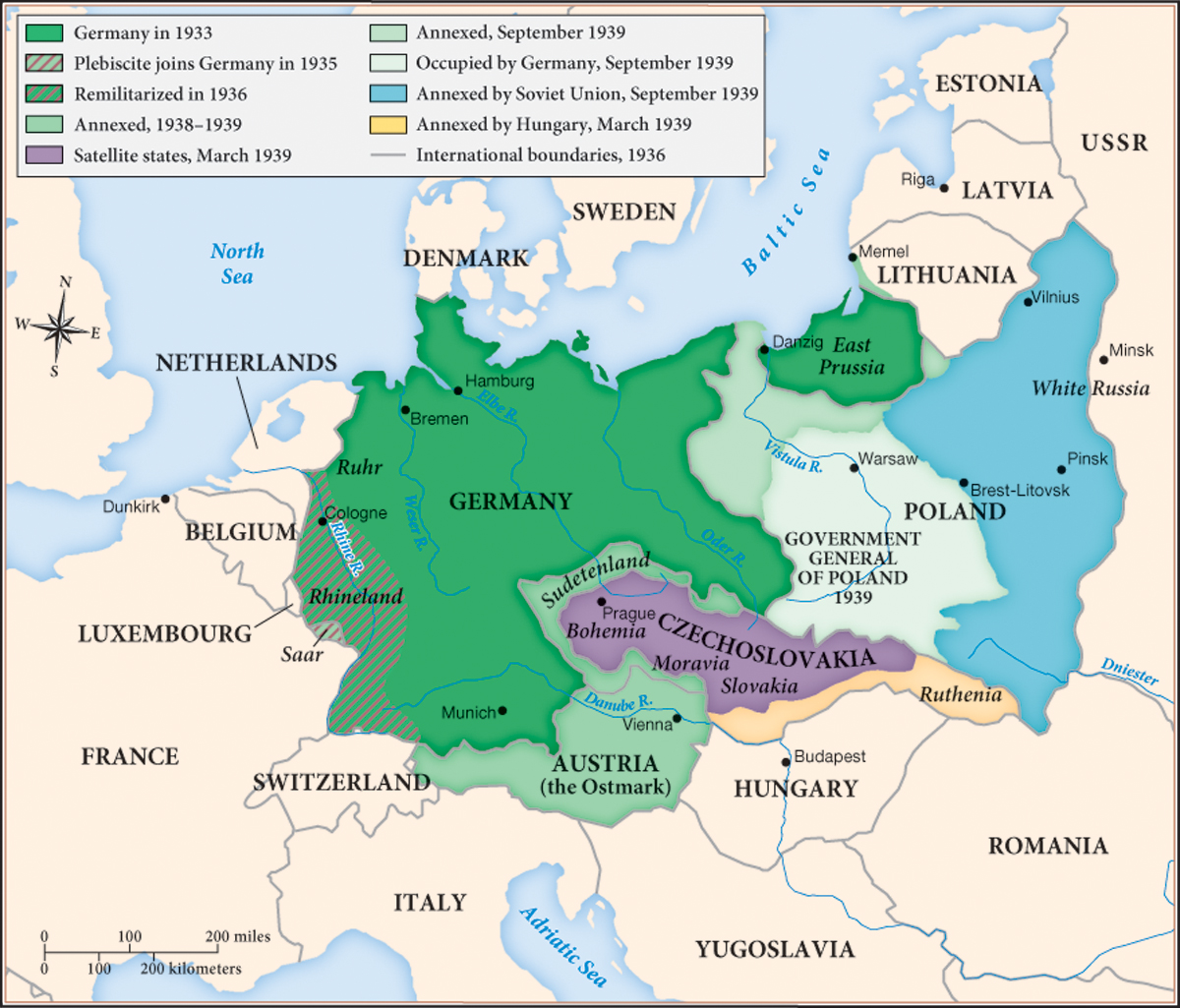Hitler’s Conquest of Central Europe, 1938–1939
Printed Page 878
Important EventsHitler’s Conquest of Central Europe, 1938–1939
The next step toward World War II was Germany’s annexation of Austria in 1938. Many Austrians had actually wished for a merger, or Anschluss, with Germany after the Paris peace settlement stripped them of their empire. So Hitler’s troops simply entered Austria, and the joy of Nazi sympathizers there made the Anschluss appear an example of the Wilsonian idea of self-determination by unifying so-called Aryan peoples into one nation. The Nazi seizure of Austria’s gold marked an important step in financing German expansion, as Austria was declared a German province. Nazi thugs ruled once-cosmopolitan Vienna; an observer later commented on the scene: “University professors were obliged to scrub the streets with their naked hands, pious white-bearded Jews were dragged into the synagogue by hooting youths and forced to do knee-exercises and to shout ‘Heil Hitler’ in chorus.” Nazis gained additional support in Austria by attacking the stubborn problem of unemployment—especially among the young and out-of-work rural migrants to the cities. Factories sprang up overnight, and German policies eliminated some of the pain Austrians had suffered when their empire had been reduced to a small country after World War I.
With Austria firmly in his grasp, Hitler turned next to Czechoslovakia and its rich resources. Conquering this democracy looked more difficult, however, because Czechoslovakia had a large army, strong border defenses, and efficient armament factories. The Nazi propaganda machine swung into action, accusing Czechoslovakia of persecuting its German minority. By October 1, 1938, Hitler warned, Czechoslovakia would have to grant autonomy (amounting to Nazi rule) to the German-populated border region, the Sudetenland, or face German invasion.
Hitler gambled correctly that the other Western powers would choose appeasement, the prevention of conflict by making concessions for grievances (in this case, the treatment of Germany in the Treaty of Versailles). As the October deadline approached, British prime minister Neville Chamberlain, French premier Edouard Daladier, and Mussolini met with Hitler at Munich and agreed not to oppose Germany’s claim to the Sudetenland. Appeasement was widely seen as positive at the time, and the Munich Pact prompted Chamberlain to announce that he had secured “peace in our time.” Having portrayed himself as a man of peace, Hitler waited until March 1939 to invade the rest of Czechoslovakia (Map 26.2). Whether the Munich Pact bought Hitler time to build his army and gave him the green light for further aggression or whether it wisely provided France and Britain precious time to beef up their own armies is heatedly debated even today.

REVIEW QUESTION How did the aggression of Japan, Germany, and Italy create the conditions for global war?
Stalin, excluded from the Munich deliberations, saw that the democracies were not going to fight to protect eastern Europe. He took action. To the astonishment of people in the West, on August 23, 1939, Germany and the USSR signed a nonaggression agreement. The Nazi-Soviet Pact provided that if one country became embroiled in war, the other country would remain neutral. Moreover, the two dictators secretly agreed to divide Poland and the Baltic states—Latvia, Estonia, and Lithuania—at some future date. The Nazi-Soviet Pact ensured that, should war come, the democracies would be fighting a Germany that feared no attack on its eastern borders. The pact also allowed Stalin extra time to reconstitute his officer corps, which had been wiped out by the purges. In the belief that Great Britain and perhaps even France would continue not to resist, the Nazis now targeted Poland.